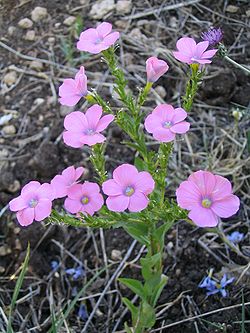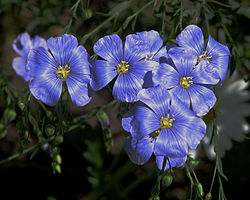Bob
Have a question related to this hub?
Alice
Got something to say related to this hub?
Share it here.
| Linum | |
|---|---|

| |
| Linum pubescens | |
| Scientific classification | |
| Kingdom: | Plantae |
| Clade: | Tracheophytes |
| Clade: | Angiosperms |
| Clade: | Eudicots |
| Clade: | Rosids |
| Order: | Malpighiales |
| Family: | Linaceae |
| Subfamily: | Linoideae |
| Genus: | Linum L. |
| Species | |
|
about 200, see text | |
Linum (flax) is a genus of approximately 200 species[1][2] in the flowering plant family Linaceae. They are native to temperate and subtropical regions of the world. The genus includes the common flax (L. usitatissimum), the bast fibre of which is used to produce linen and the seeds to produce linseed oil.

The flowers of most species are blue or yellow, rarely red, white, or pink, and some are heterostylous. There is an average of 6 to 10 seeds per boll.
Linum species are used as food plants by the larvae of some Lepidoptera species including the cabbage moth, the nutmeg, the setaceous Hebrew character and Coleophora striolatella, which feeds exclusively on Linum narbonense.
Several flaxes are cultivated as garden ornamentals, including the blue-flowered species blue flax (L. narbonense), Lewis' blue flax (L. lewisii), and perennial blue flax (L. perenne), the red-flowered scarlet flax (L. grandiflorum), and the yellow-flowered golden flax (L. flavum). In Eurasia, since Roman times, the genus Linum has been cultivated not only for its plant fiber, but also its seeds and tender leaves for culinary usage.[3]
